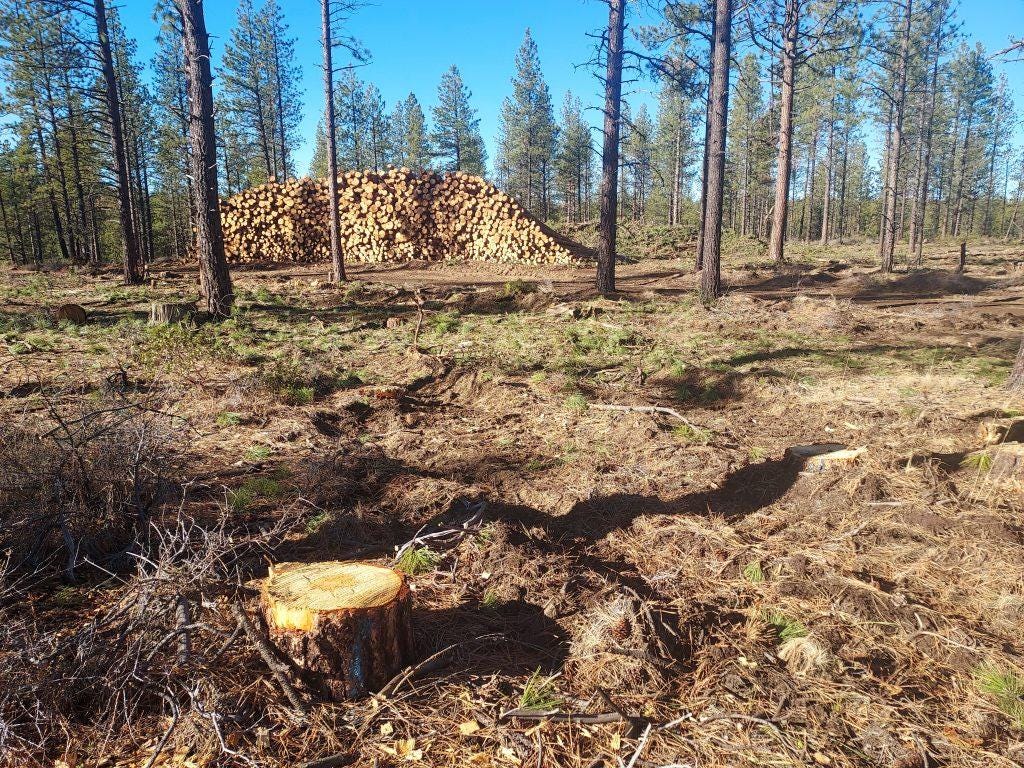Deforestration on Deschutes National Forest
In a futile effort to preclude wildfire, the Deschutes NF is severely alternating the natural landscape through logging.
The 1.6 million acres of the Deschutes National Forest are engaged in an active deforestation effort, all justified based on precluding or slowing wildfires. The Forest also suggests that the logging is "restoring" historical forest conditions.

After the spotted owl controversy of the 1980s, the Forest Service lost its social license to log public forests to subsidize the private timber industry. Searching for a new justification for logging, the Forest Service adopted the threat of wildfire as its new excuse for logging.

To this end, the federal government has funded this new excuse for logging.
The Deschutes National Forest is part of one of 21 focal landscapes under the Forest Service's Wildfire Crisis Strategy. Consequently, the Deschutes National Forest "continues to use targeted investments to increase the pace and scale of reducing wildfire risk to our communities and landscapes."

With federal funding from the Bipartisan Infrastructure Law, Inflation Reduction Act, Collaborative Forest Landscape Restoration, and Joint Chief's funding, the Deschutes National Forest treated 8,950 acres with prescribed fire and 41,504 acres of mechanical fuel reduction (euphemism for logging), including thinning, mowing, and yarding.
During these 2023 "fuel reductions, commercial thinning on the Deschutes National Forest produced 26.2 million board feet of timber.

One problem with these thinning schemes is that they usually require road access. Research has demonstrated that most human ignitions occur within a few hundred feet of roads. Thus, the continued construction of new logging roads enhances the chances of more wildfires and has numerous other associated collateral damage to everything from water quality to spread of weeds to damage of wildlife habitat.
In 2023, wildfires burned just 44 acres of the Deschutes National Forest. However, of these ignitions, firefighters determined 81 fires to be caused by humans or an undetermined cause, with 30 started by lightning.
The above statistics support several contentions about wildfires. Historically, most blazes remain small due to climate conditions, not because of fuels. The only time you get large wildfires that burn many thousands of acres is when you have drought combined with high temperatures, low humidity, and, most importantly,

Under extreme fire weather conditions, wildfires are unstoppable. So the very blazes "fuel treatments" are designed to thwart, are the ones logging and prescribed burning can't influence. Indeed, there is evidence that suggests logging can increase high severity blazes.

A further problem with the Deschutes NF justification for restoring "historical" conditions is that whatever conditions they deem historic resulted from the climate at that time. Today's climate is considerably drier and hotter than in the 1800s when we were at the tail end of the Little Ice Age or even the mid-century between 1940 and 1980 when a cool, moist period led to the growth of glaciers. During these wetter, cooler periods, wildfire ignitions were fewer, and less acreage was burned.
One problem associated with thinning the Forest is that it exacerbates two factors responsible for wildfire spread: enhanced wind penetration, which dries the soil, contributing to vapor pressure deficits.

Another problem with the Forest Service deforestation program is that it removes significant carbon stored in tree boles. Logging and wood products production typically release carbon into the atmosphere, contributing to greater greenhouse gas emissions.
Since one of the justifications of the Deschutes NF logging program is to protect trees from mortality from high-severity fires, one must ask how many trees are killed by chainsaws trying to preclude wildfires. Such chainsaw medicine often removes as much as 50-75% of the trees, which are never counted as a mortality source by the Forest Service.
A further issue on the Deschutes NF is that the agency tends to remove smaller trees. A distorted age class can reduce forest resiliency. For instance, mountain pine beetles tend to attack mature trees. An insect outbreak might lead to significant mortality of large trees. Still, in typical situations, an understory of smaller trees that the insects ignore can buffer the impact of insect mortality. Such "hedge betting" is ignored by Deschutes NF policies.

The Deschutes National Forest is aggressively modifying the Forest to protect nearby communities like Sisters, Sun River, and Bend. However, numerous studies have demonstrated that the most effective way to protect communities is by working from the home outward to reduce flammability. As wildfire researcher Jack Cohen has shown, treating a forest more than 100 feet or so from a home provides little additional security from wildfire.


I agree- the way the DNF is being managed is wrongheaded and is like fighting the last war. You're completely correct- tactics developed in cooler wetter times aren't effective now.